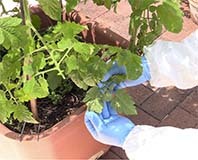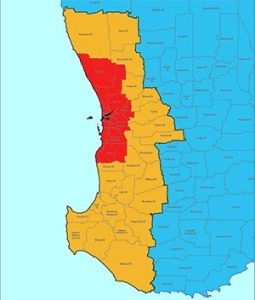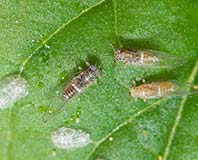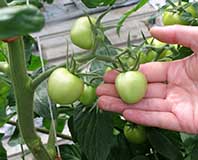Read the latest information on
Foot-and-mouth disease

Please check your plants for signs of the tomato potato psyllid
The Tomato Potato Psyllid National Management Group has advised that it is not technically feasible to eradicate the tiny sap sucking pest from Western Australia, where it was first found earlier this year.
Now, a plan is being developed to manage the pest, to limit its further spread and the impact on growers in other areas of WA and in other states and territories. Since the detection of tomato potato psyllid, interstate movement controls for risk material have been in place and continue to apply.
Overseas, the psyllid has been associated with the spread of a serious plant disease known as ‘zebra chip’ in potatoes. So far, the organism that causes zebra chip, Candidatus Liberibacter solanacearum has not been found in Australia. Surveillance is being done to confirm its absence.
It doesn’t matter if you are a commercial grower or only keep a few plants in your backyard, everyone who grows potato, tomato, eggplant, capsicum, chilli, tamarillo or sweet potato plants should check their plants for the tomato potato psyllid.
More information about the psyllid, including photos to help you identify it, is available on the WA Department of Primary Industries and Regional Development website, and the PHA website. The tomato potato psyllid and symptoms of zebra chip in potatoes are described below.
In Western Australia, if you think the psyllid may be present in your plants, you should still report this to the Exotic Plant Pest Hotline on 1800 084 881 or you can use the MyPestGuide reporting App.
If you suspect you have seen the psyllid outside of Western Australia, you need to contact your state or territory department of agriculture or primary industries. You can do this by phoning the Exotic Plant Pest Hotline on 1800 084 881.
Industry body AUSVEG has appointed a dedicated coordinator, Alan Nankivell, to help growers to manage tomato potato psyllid. Vegetable growers who need biosecurity advice can also contact AUSVEG Biosecurity Officers Jessica Lye or Callum Fletcher.

The tomato potato psyllid quarantine area is around Perth in WA. Click on the image for a larger version.
Even though the psyllid is now established in parts of Western Australia, it’s important to control the tomato potato psyllid and prevent its spread to non-infested areas. It can spread through the movement of tomato, capsicum, eggplant, tamarillo and other Solanaceous plant material. It can also occur on the Convolvulaceae plant family, which includes sweet potato. It can disperse through natural pathways such as flight and on the wind.
The Quarantine Area Notice currently remains in place for the Perth metropolitan area and surrounds to help prevent the spread of the psyllid.
States and territories have proposed a consistent approach to movement restrictions that will apply to risk plants and plant material produced in Western Australia.
If you are planning to move host material interstate you need to check with your state or territory department of agriculture or primary industries to see if any of these restrictions affect you. You should check the Australian Interstate Quarantine website before ordering or transporting plants or plant material from Western Australia. For example, see WA ICAs 60, 61 and 62 that refer to the inspection of strawberries for the psyllid, packhouse washing of carrier produce, and treatment and inspection of nursery stock.
Restrictions on the movement of host plants and products also apply to travellers. More information is available in the latest edition of the booklet Australian Interstate Quarantine: A Traveller’s Guide.
 Tomato potato psyllid (Bactericera cockerelli) adults are about 3mm long. The body is brownish and has white or yellowish markings on the thorax and a broad white band on the abdomen. Their wings are transparent and held vertically over their body.
Tomato potato psyllid (Bactericera cockerelli) adults are about 3mm long. The body is brownish and has white or yellowish markings on the thorax and a broad white band on the abdomen. Their wings are transparent and held vertically over their body.
When it’s present in a crop, the noticeable signs of the tomato potato psyllid include:
The tomato potato psyllid is a significant production pest in other countries where it is present, which includes the USA, Central America, New Zealand and Norfolk Island (which is an external Australian territory).

Tomato plants affected by Clso have mishaped fruit. Photo: WA DPIRD
Candidatus Liberibacter solanacearum is a bacterium associated with ‘zebra chip’ disease in potatoes.
Zebra chip disease results in reduced crop yield and crop health, stem death, yellowing of leaf tissue, and misshapen tubers.
Symptoms of the Candidatus Liberibacter bacterium on potatoes, tomatoes, capsicum and chilli may look similar to other plant conditions, so growers are urged to be vigilant for the following symptoms: